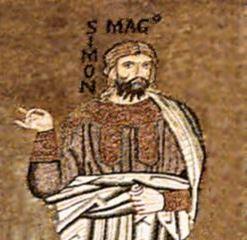Simon Magus

Simon Magus is a fascinating and somewhat mysterious figure from early Christian tradition, often seen as the archetypal heretic or false prophet. Here's a quick breakdown of who he was and why he's notable:
1. Biblical Mention (Acts 8:9–24)
Simon first appears in the Acts of the Apostles in the New Testament:
-
He was a sorcerer or magician in Samaria, who amazed people with his powers and claimed to be "someone great."
-
After hearing the preaching of Philip, he believed and was baptized, but later offered the apostles money in exchange for the power to impart the Holy Spirit.
-
This act of trying to buy spiritual power is where we get the term “simony”—the buying or selling of ecclesiastical privileges.
-
The Apostle Peter sharply rebukes him, telling him his heart is not right before God.
2. Writings & Legends
Outside the Bible, Simon's story grows in the early Christian writings and apocrypha:
-
Early Church Fathers like Irenaeus, Justin Martyr, and Hippolytus wrote about Simon as the founder of Gnosticism or at least a proto-Gnostic figure.
-
He was said to have traveled with a woman named Helen, whom he claimed was a divine emanation or Ennoia (divine thought), who had fallen into the material world.
-
He believed himself to be a manifestation of the divine power, sometimes equated with God or the Messiah—clearly heretical in the eyes of orthodox Christianity.
3. Mythic Elements
Some wild stories surround Simon:
-
He allegedly performed miracles or magic tricks to convince people of his divinity.
-
One legend claims he tried to fly in front of Emperor Nero, only to fall to his death after Peter and Paul prayed against him.
-
He’s sometimes seen as a rival to St. Peter, representing false doctrine versus apostolic truth.

